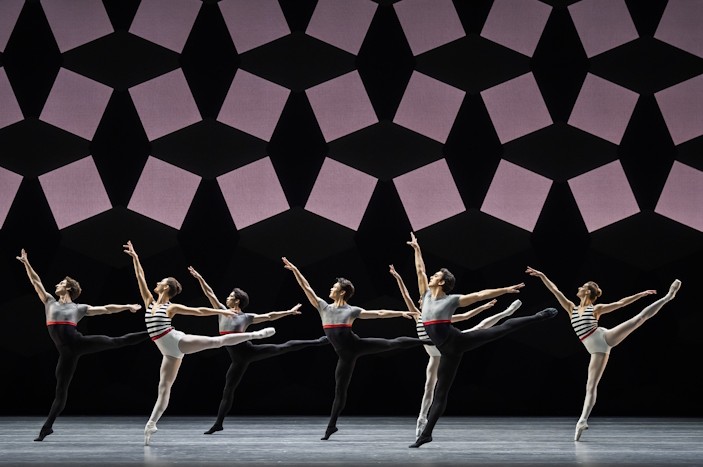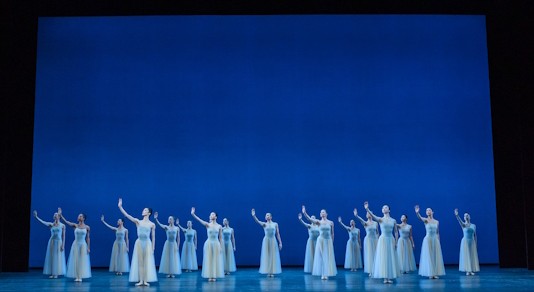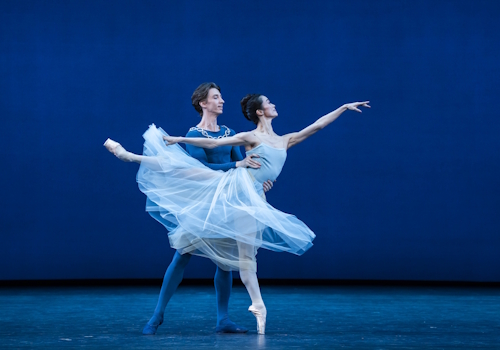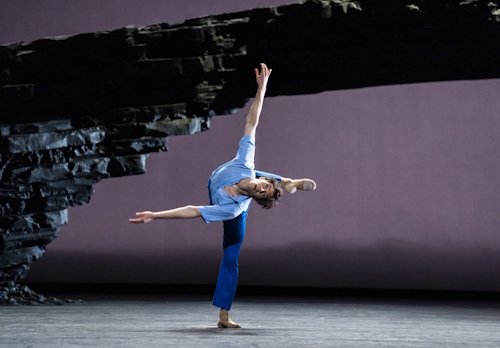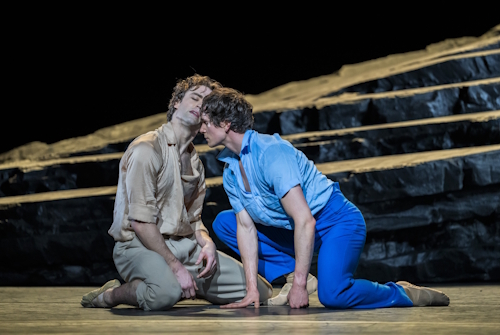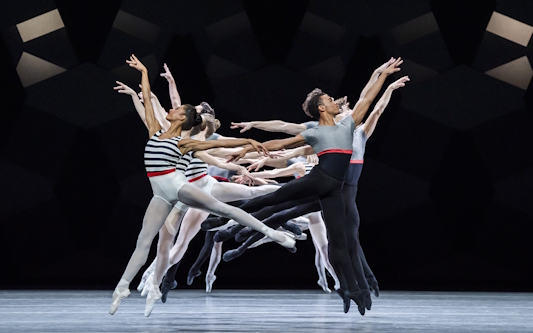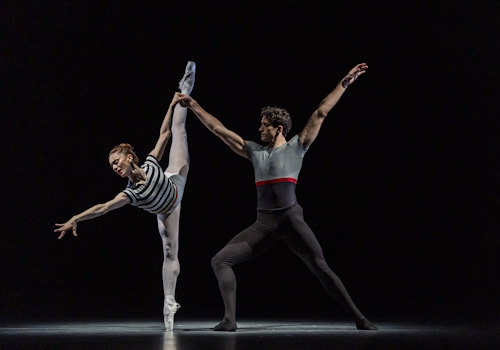Royal Ballet & Opera, London
November 14, 2025
Perspectives. It’s hard to think of a more appropriate title for an evening that presented three views of ballet: George Balanchine’s restrained neoclassism, Cathy Marston’s approach to narrative, and Justin Peck’s 21st-century New York energy. It’s not perfect. It is possible to take issue with elements in each, but it’s a triple-bill that’s classy and classic in pretty much every way.
It’s difficult to believe, but Balanchine’s Serenade is now over ninety years old. Given the high regard in which the ballet is now held, it also now seems incredible to think that some were not exactly effusive when first seen in New York, danced by the American Ballet in 1935 (its first public outing was actually on December 8 the previous year by the School of American Ballet in Hartford, Connecticut). “Serviceable rather than inspired,” was the opinion of prominent critic John Martin.
It must have looked and felt very different then, though, with the women in round-neck, knee-length dark dresses with equally dark tights and shoes. The Karinska costumes we know today didn’t debut until 1952. Balanchine also rechoreographed and added sections through the years,
The famous opening tableau brings an immediate sigh of contentment. Under cool blue light, seventeen women stand, an arm outstretched, as Tchaikovsky’s Serenade for Strings fills the auditorium. “See the music, hear the dance,” is an oft-quoted Balanchine saying, and nowhere is it more true than in Serenade. There is no story, although he left plenty of space for interpretation.
It’s roots as a student work are evident in the way the steps and the architechture of the work gradually get more difficult. Everyone danced beautifully. The wonderfully expressive Fumi Kaneko shone throughout, partnered perfectly by Vadim Muntagirov. Melissa Hamilton and Ryoichi Hirano brought a lovely calm sobriety to their adagio. Leticia Dias sparkled in her solos.
For all that, I do prefer the way the ballet is danced at New York City Ballet, where it is taken at a notably brisker pace in places. From first note to last, they get through it over two minutes quicker. That’s a lot. That’s not to say The Royal Ballet is ‘wrong’ though, just different.
Cathy Marston’s Against the Tide is set to Benjamin Britten’s Violin Concerto, written in 1938-39 as Europe edged ever closer to war. Although the composer never openly linked the music to world events, it seems inconceivable that it didn’t have some influence.
That the ballet has a narrative is unmistakeable. Marston has declined to elaborate on what it is, however, preferring the audience to make up its own mind, saying simply that the work was dictated by the music.
The choreography matches the music in being deeply felt. There are brighter moments, not least in a spirited dance for William Bracewell, the central figure, and the men, presumably his friends, but the looming shadows cannot be escaped, it seems. Throughout, one senses an anxious mood in the orchestra that is reflected in the ballet’s overall mood.
It opens with Bracewell standing against set designer Chloe Lamford’s blackened stone bridge that looks as if it has been lifted from some northern mill town. As elsewhere, his dance reflects the violin. A duet with Matthew Ball is intense, their two bodies folding around each other with ease. Knowing the background to the music, it’s impossible not to read what appear to be his male friends, led by Nicol Edmonds in uniform, as enticing Bracewell to enlist, although he remains uncertain.
Could the ballet’s sole female figure, danced by Melissa Hamilton, be his mother? Or perhaps just ‘women’ in general? Whichever, she appears to ease his doubts but leaves just before the men, now all in uniform, return. When Bracewell crosses the never-ending bridge at the end, is he heading to join them? Or, against the tide, to coin a phrase.
Britten’s music was previous used for Matthew Hart’s less than successful Dances with Death, a ballet about AIDS, in 1996. I think it’s safe to say the deeply thoughtful Against the Tide will be around rather longer.
Everywhere We Go is one of New York City Ballet resident choreographer and artistic adviser Justin Peck’s best ballets. If there’s a quibble about it, his first to be performed by The Royal Ballet, it’s that its almost too full of invention and ideas. Danced to a commissioned score by Sufjan Stevens, which it fits like a glove, it’s almost too much of a good thing.
It’s packed with Peck’s trademark use of the large corps, that comes together individually, in pairs and groups large and small. They flood in from the left and right. Patterns form and dissolve with remarkable ease. The soloists emerge from and retreat back into the ensemble. And it’s all done at speed and with a super energy to match the ever-changing rhythmic dynamics of the score, although I have to say again, not quite matching that at NYCB. Yet.
The ballet develops over nine sections with titles such as ‘The Shadows Will Fall Behind’ (the first), ‘Happiness is a Perfume’ (the second) and ‘There Is Always the Sunshine’ (the fifth), not that there is generally much obvious connection between those names and the choreography. Time and again, images painted hark back to something seen previously, almost always developed in some way, which gives the work coherence. And that’s before we get to the final movement, ‘Thanks to the Human Heart By Which We Live’, a sort of edited highlights of the ballet.
It’s not all fast, the one longer slower section being gorgeously danced by Reece Clarke and Marianela Nuñez.
It all takes places against Karl Jensen’s changing backdrop of geometric shapes that sometimes appear to be mirrored by the patterns and movement below. The costumes, with horizontally-striped tops, designed by former NYCB principal dancer Janie Taylor, are gorgeous too.
The forty minutes whizzed past. Everywhere We Go is a ballet that cannot fail to leave you energised, even if the end is surprisingly quiet. Perspectives really is a cracking evening. Maybe too much of a good thing is sometimes not a bad thing at all.

